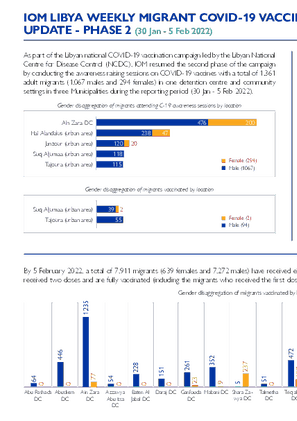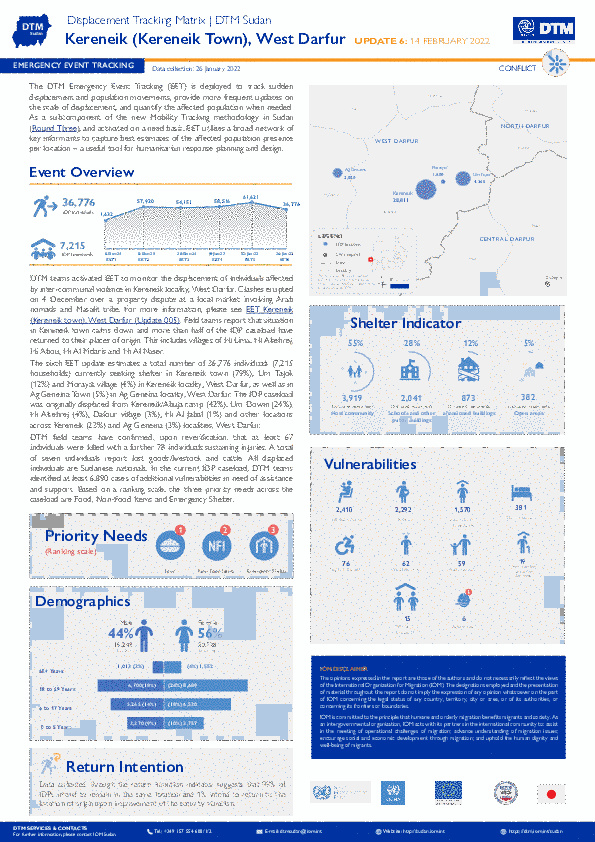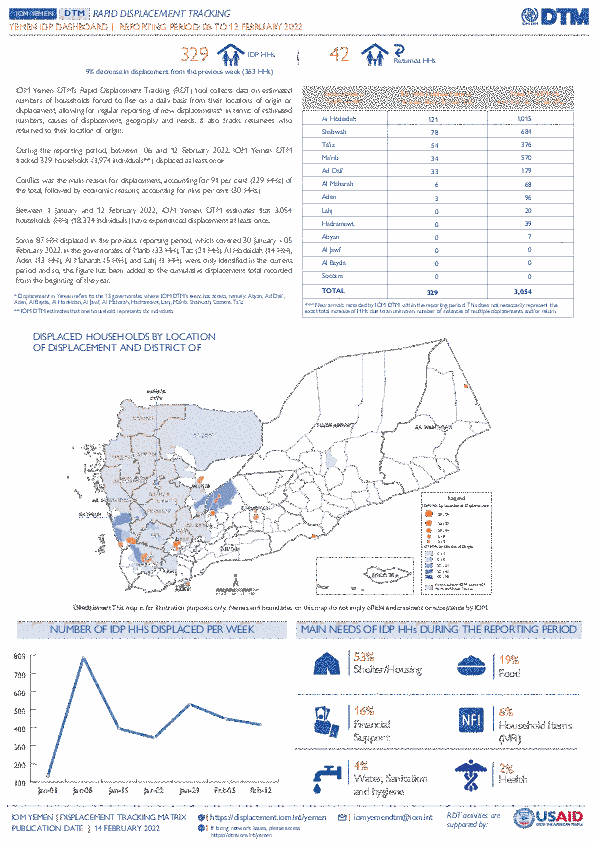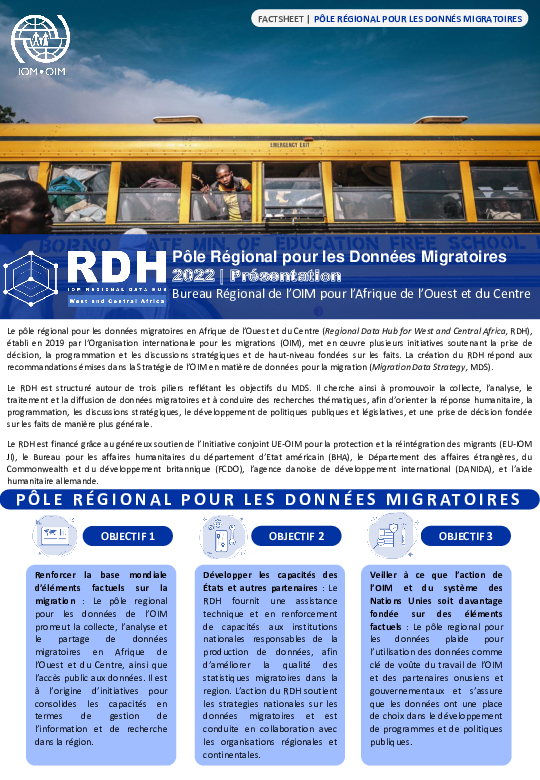-
Countries
-
Data and Analysis
-
Special Focus
-
Crisis Responses
Cette fiche d'information fournit un aperçu des activités de collecte, analyse et diffusion de données relatives aux déplacements forcés conduites par la Matrice de suivi des déplacements (Displacement Tracking Matrix, DTM) en Afrique de l'Ouest et du Centre, de même que le rôle du Pôle régional pour les données migratoires (Regional Data Hub, RDH) du Bureau régional de l'OIM pour l'Afrique de l'Ouest et du Centre en relation avec ces activités.
Cette fiche d'information présente les activités, objectifs et structure du Pôle régional pour les données migratoires du Bureau régional de l'OIM pour l'Afrique de l'Ouest et du Centre.

Contact
DTM Libya, DTMLibya@iom.int
Language
English
Location
Libya
Period Covered
Feb 06 2022
Feb 12 2022
Activity
- Other
As part of the Libyan national COVID-19 vaccination campaign led by the Libyan National Centre for Disease Control (NCDC), IOM resumed the second phase of the campaign by conducting the awareness raising sessions on COVID-19 vaccines with a total of 644 adult migrants (619 males and 25 females) in two detention centres and community settings in two Municipalities during the reporting period (6 - 12 Feb 2022).

Contact
DTM Libya, DTMLibya@iom.int
Language
English
Location
Libya
Period Covered
Jan 30 2022
Feb 05 2022
Activity
- Other
As part of the Libyan national COVID-19 vaccination campaign led by the Libyan National Centre for Disease Control (NCDC), IOM resumed the second phase of the campaign by conducting the awareness raising sessions on COVID-19 vaccines with a total of 1,361 adult migrants (1,067 males and 294 females) in one detention centre and community settings in three Municipalities during the reporting period (30 Jan - 5 Feb 2022).

Contact
DTM Uganda, dtmuganda@iom.int
Language
English
Location
Uganda
Period Covered
Jan 01 2022
Jan 31 2022
Activity
- Mobility Tracking
On the 24th January 2022, Kisoro Districts was hit by heavy rains that triggered mudslides and floods in two subcounties
(Muramba and Nyarusiza). This report provides an overview of needs and conditions.

Contact
DTM Sudan; dtmsudan@iom.int
Language
English
Location
Sudan
Snapshot Date
Jan 26 2022
Activity
- Mobility Tracking
- Event Tracking
The DTM Emergency Event Tracking (EET) is deployed to track sudden displacement and population movements, provide more frequent updates on the scale of displacement, and quantify the affected population when needed. As a subcomponent of the new Mobility Tracking methodology in Sudan (Round Three), and activated on a need basis, EET utilises a broad network of key informants to capture best estimates of the affected population presence per location – a useful tool for humanitarian response planning and design.

Contact
DTM Pakistan, iomisbdtmremapteam@iom.int
Language
English
Location
Pakistan
Period Covered
May 23 2021
Jun 05 2021
Activity
- Flow Monitoring
IOM Pakistan collects data on the outflows of undocumented Afghan migrants at the Torkham and Chaman border crossing points in an effort to better understand the migration movements of undocumented Afghan migrants returning to Afghanistan from Pakistan. This exercise is part of the European Union funded project “Displacement Tracking Matrix Regional Evidence for Migration Analysis and Policy (DTM REMAP)”. From 23 May to 5 June 2021, 764 undocumented Afghan migrants returned to Afghanistan, including 259 through the Torkham border point and 505 through the Chaman border point. During the reporting period, border authorities facilitated the return of 67 individuals due to the lack of legal documentation to remain in Pakistan. Therefore, information concerning these 67 individuals is not included in the report analysis.

Contact
DTM Pakistan, iomisbdtmremapteam@iom.int
Language
English
Location
Pakistan
Period Covered
Jan 01 2020
Nov 07 2020
Activity
- Flow Monitoring
1,146 individuals returned through the Torkham border and 4,622 individuals returned through the Chaman/Spin Boldak border. Out of these returnees, border authorities facilitated the return of 307 individuals who returned through Torkham and 187 who returned through Chaman due to the unavailability of legal documentation to remain in Pakistan. Therefore, analysis for 494 individuals is not available in this report.

Contact
DTM Yemen, iomyemendtm@iom.int
Language
English
Location
Yemen
Period Covered
Feb 06 2022
Feb 12 2022
Activity
- Rapid Emergency Registration
- Mobility Tracking
IOM Yemen DTM’s Rapid Displacement Tracking (RDT) tool collects data on estimated numbers of households forced to flee on a daily basis from their locations of origin or displacement, allowing for regular reporting of new displacements in terms of estimated numbers, geography, and needs. It also tracks Returnees who returned to their location of origin.
From 01 January 2022 to 12 February 2022, IOM Yemen DTM estimates that 3,054 households (HH) (18,324 Individuals) have experienced displacement at least once.
Since the beginning of 2022, DTM also identified 10 displaced households who left their locations of displacement and either moved back to their place of origin or another location.
Between 06 and 12 February 2022, IOM Yemen DTM tracked 329 households (1,974 individuals) displaced at least once. The top three governorates and districts where people moved into/within are:
- Al Hodeidah (121 HH) – Hays (97 HH), Al Khukhah (24 HH) districts. Most displacements in the governorate were internal.
- Shabwah (78 HH) – Ataq (52 HH), Bayhan (11 HH), Osaylan (9 HH) districts. Most displacements in the governorate originated from Shabwah and Ibb.
- Taiz (54 HH) – Jabal Habashi (45 HH), Al Maafer (6 HH), Al Misrakh (3 HH) districts. Most displacements in the governorate were internal.
Most displacements resulted from the increased conflict in the following governorates and districts.
- Al Hodeidah (129 HH) – Hays (82 HH), At Tuhayta (23 HH), Bayt Al Faqih (12 HH) districts.
- Taiz (71 HH) – Jabal Habashi (41 HH), Maqbanah (24 HH), Sharab Ar Rawnah (2 HH) districts.
- Shabwah (39 HH) – Bayhan (16 HH), Ayn (13 HH), Osaylan (10 HH) districts.

Contact
DTM Yemen, iomyemendtm@iom.int
Language
English
Location
Yemen
Period Covered
Jan 01 2022
Jan 31 2022
Activity
- Points of Entry (PoE)
HIGHLIGHTS (From 01 to 31 January 2022)
• 894 new cases – 27 new deaths | source: WHO
• Updates on numbers of new cases in areas controlled by the De Facto Authorities (DFA) based in Sana’a are not available.
• 5,940 non-Yemeni migrants arrived at the Yemeni southern governorates of Lahj and Shabwah, and 5,760 Yemeni returnees arrived in Yemen from Kingdom of Saudi Arabia (KSA). (Please see January FMR report for more details). IOM has begun a COVID-19 vaccination campaign for migrants stranded in Yemen, aiming to inoculate around 7,500 people at its Migrant Response Points in Aden and Ma’rib.
• No IDP households (HH) reported COVID-19 as the reason of displacement. So far, the total number of IDP HHs who have cited COVID-19 as the primary reason for displacement is 1,559 households.
• WHO and IOM have expressed their concern about discrimination against migrants in Yemen regarding COVID-19, calling on national authorities and citizens to continue their generous and known acceptance over the years of communities at risk and their support, including the migrant community.

